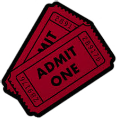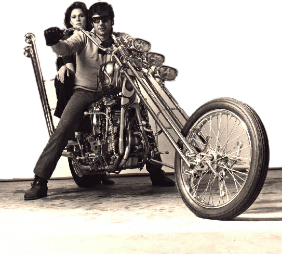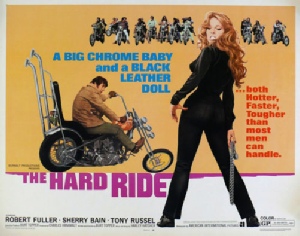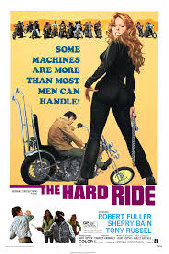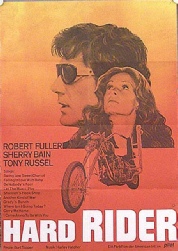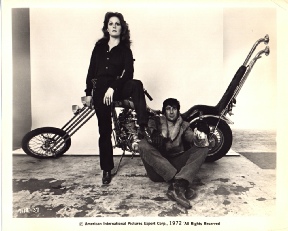ABOUT THE FILM
“The most important thing is to make the films you believe in.” Burt Topper, 2004
The Hard Ride was produced and released by American International Pictures, the maverick company started in the fifties (as American Releasing Corp.) by visionaries Samuel Z. Arkoff and James H. Nicholson. They were the first to recognize and target the underserved teenage market and they churned out not only fun, commercially viable genre movies but launched the careers of more than a few directors and actors, including Roger Corman and Burt Topper.
Director/writer/producer Burt Topper, who became in-house head of AIP production in the mid-sixties, was known to be an auteur, to make films which were profitable for AIP, but were fast, cheap and personal. The Hard Ride was the only “biker” movie he was wholly responsible for but he had several war themed movies to his credit including those he made based on his own experiences in WWII, Hell Squad (1958); Tank Commandos (1959); War is Hell (1961).
With The Hard Ride, released as it was during the twilight of the biker-flick phenomenon, Topper, his crew and leads Robert Fuller and Sherry Bain garnered good reviews but also achieved a trifecta—something for everybody and completely unique. The Hard Ride had the cycles, action and raw appeal of a grindhouse; the look and sound of an art-house; and the contemplative feel of a character-driven drama about brotherhood, racism, disharmony, the counterculture.
In 1971, while Hollywood was still a few years away from dealing explicitly with fallout from the Vietnam war, The Hard Ride was one of the first movies to feature not only the character of a returning Vietnam veteran, but one in a positive light. Phil is a misunderstood outsider in his homeland and subjected to its newest prejudices, but he is heroic and morally stable rather than vengeful or psychologically broken. The Hard Ride brings the mores of the day into every aspect of its story while taking no political position. However, unusual for its genre, the film does take a stand against racial prejudice through its plot and sympathetic characters, while deftly avoiding the pitfall of preachiness.
In fact, in his sardonic wisdom as scriptwriter, Burt Topper takes on or debunks virtually every stereotype and prejudice of the times and nobody in the film is spared judgement by any other group, including a middle-aged bar patron whose drunken anti-Vietnam, anti-government rant steals a major scene from the film’s stars. Sixties pop star/actor Fabian appears in a hilarious, uncredited cameo as The Man, teenagers stereotype the bikers, the bikers the Vietnam vet, everybody stereotypes the girls who gaze hungrily at Phil the stud, and Father Tom is the hippest biker-priest this side of Yosemite.
Sherry Bain is a revelation as the beautiful, vulnerable Sheryl and her multi-layered screen presence defies the poster image of a man-eating biker chick who for no reason is wielding a chain.
In an astonishing performance, perfectly understated given he is victimized from every direction, Robert Fuller’s Phil Duncan is compelling, and heartbreaking – from his unassuming dignity, to his painfully brief moments of unbridled passion on the road with Baby and Sheryl. Despite all the warning signs – in the ads, the music, the story, the biker-flick canon itself – it’s impossible not to look for him at the end, standing by his buddy’s grave.
Outside of its success as pure entertainment for the youth and drive-in cultures, a dozen themes anchor The Hard Ride to every era since its first screening over four decades ago and, along with Harley Hatcher’s soundtrack, it has enjoyed a fascinating resurgence on DVD and online. If the film has a failing from a story perspective, it is this: it was too aware of its time, packed in too many important issues of the day that couldn’t be explored in its 93 minutes. Because The Hard Ride was PG rated and lacked the frenetic tempo of exploitation, sex and violence expected of its genre and its provocative marketing blitz, it baffled the grindhouse crowd.
But the iconic knucklehead chopper? What self-respecting outlaw could resist the challenge of this tagline: “Some machines are more than most men can handle”. Baby is still as much a marvel to motorcycle buffs and devoted riders today as she was back then. Radio listeners and peaceniks in 1971 were lured by the soothing “War is Hell” ads for a film about “a man’s love for a friend, a woman’s love for a man, and their love of living.” And the kids were alright! The chemistry between hot leads Robert Fuller and Sherry Bain, their open air, love-in-the-saddle road trip, Robert Sparks’ lush cinematography and the perpetual rocking of Harley Hatcher’s soundtrack provided plenty of inspiration.
In the backseat.
At the Drive-In.
No matter what their expectations going in, audiences, and critics, came away surprised.
While the ending didn’t shock movie-goers accustomed to the downbeat nihilism of the biker-film genre or cynicism of the seventies in general, it was controversial to everyone who cared deeply for that universal soldier with no apparent home, on his noble journey to honour the friend, the brother he fought beside. Some perceived Phil Duncan’s death as an allegory, a symbol of waste, owing to the dark shadow Vietnam cast over the American political and cultural climate well before 1971. By opening and closing The Hard Ride as he did, Burt Topper seemed to be making a subtler statement. If a single beacon shines in that final scene at the grave of those two dead soldiers, perhaps it is simply a call for unity.
It’s no accident that the ingenious Topper, a seasoned writer/filmmaker, war veteran and author of war-themed films, is in complete command of the direction and the enigmatic vision of The Hard Ride.
In the end, it is Robert Fuller’s loyal Marine Sergeant Duncan who carries the film’s unforgettable messages of honour, friendship, acceptance, and that one true thing – love – all the way home.
~
BABY
The radical cycle desired by everyone in the film was designed and built by Frank Charolla of Downey Custom Cycles in California. Depending on your definition of sexy, the lovingly photographed knucklehead chopper, with her extended forks, three headlights and glistening smokestacks, could well be the breakout star of The Hard Ride! Co-star Robert Fuller, renowned by the 1971 shoot for his starring roles in westerns Laramie and Wagon Train, said at the time that riding the often temperamental chopper was “just a case of switching saddles”. He did the majority of the riding scenes himself.
